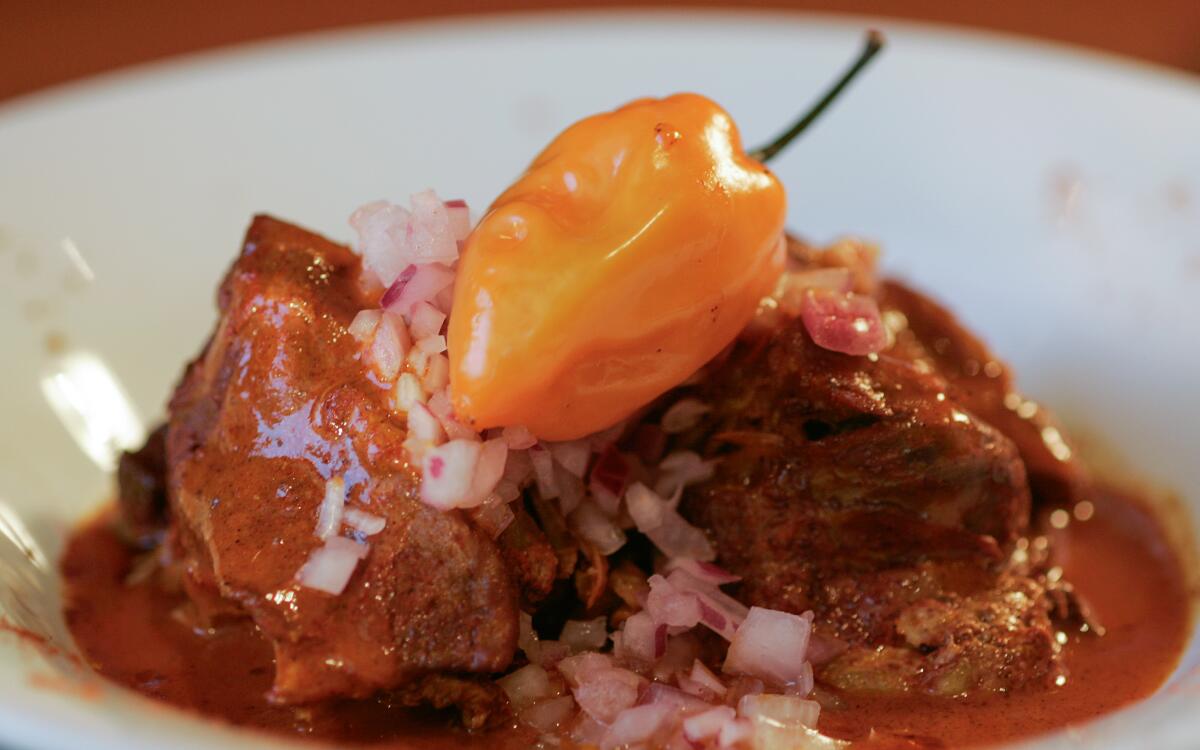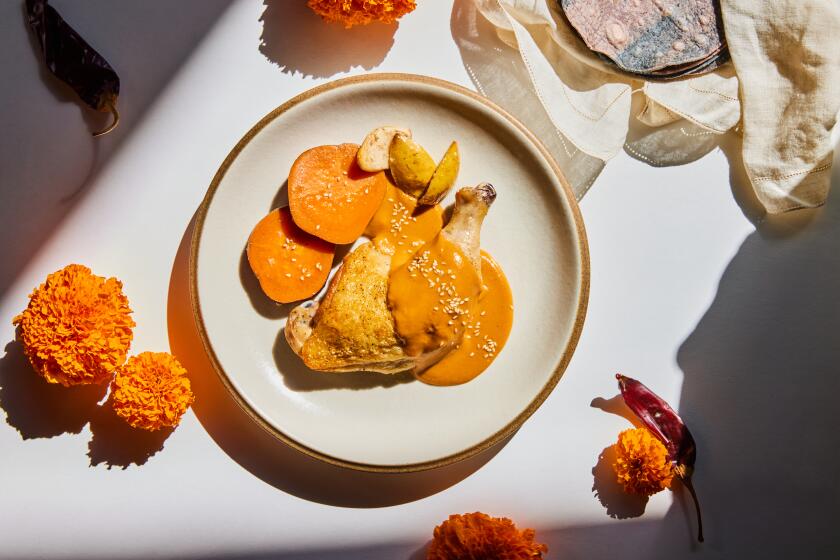Chichen Itza cochinita pibil

What started as a breakfast favorite in Mexico’s tropical Yucatan is taking L.A. by storm -- in tacos and tortas and burritos and as a plated dish. Cochinita pibil is succulent slow-roasted pork that’s so tender you can almost spoon into it. It has a depth of flavor from aromatic, earthy, rich achiote seeds that also impart a brilliant russet-red color, and at the same time, it’s bright with the flavor of Seville oranges.
“It’s the most important dish of the Yucatan,” says Gilberto Cetina, owner of Yucatecan restaurants Chichen Itza. (He opened the second Chichen Itza on 6th Street near MacArthur Park in January.)
In the small kitchen of his original restaurant in the Mercado La Paloma near USC, Cetina has gotten down to the business of making his -- and the Yucatan’s -- signature dish, cochinita pibil, pork marinated in the juice of Seville oranges, ground achiote (annatto) seeds, garlic and spices such as clove, allspice, black pepper and oregano, all wrapped up in banana leaves and slow-roasted for several hours.
The result is succulent, aromatic, tender, irresistible pork. At Mexican restaurants and taco stands across L.A., cochinita pibil is upstaging more familiar northern Mexican pork preparations such as carnitas and al pastor.
It used to be that cochinita pibil was rather elusive, tucked into the tacos and burritos at tiny Yuca’s in Los Feliz or served only on weekends at La Flor de Yucatan Bakery in South Los Angeles, but it has become increasingly in demand.
And although Los Angeles’ Yucatecan community is small, restaurants focusing on regional Mexican cuisine such as Babita in the San Gabriel Valley and La Huasteca at Plaza Mexico in Lynwood have helped put the Yucatecan specialty in the spotlight.
Breakfast of champions
Traditionally, it’s served in tacos or tortas -- for breakfast.
“In Yucatan, 5 a.m., it’s everywhere, any place you go,” says Socorro Herrera, who emigrated from Merida, Mexico, and opened the award-winning taco stand Yuca’s with her late husband in 1976. “Especially on Sundays, it’s tradition.”
And by 8 or 9 a.m., “there’s no more cochinita available,” says Cetina, who’s from the town Colonia Yucatan. “You have to eat cochinita in the morning. And 99.9% of the population eats cochinita on Sunday morning.... If you party on Saturday night, you go have your cochinita tacos and then go to sleep.”
At Chichen Itza, Cetina serves it not only in tacos and tortas but also as a main course, nestled in a shallow white bowl and topped with tangy, crunchy pickled red onions and a fresh bright-orange, searingly hot habanero, the pepper of the Yucatan.
Pibil refers to the way the pork is cooked -- traditionally in a coal-filled pit. The Mayans used not pork (domesticated pigs were introduced by the Spanish) but wild game such as rabbit, boar, venison or armadillo.
“You can make it with all different kinds of meat,” says Jimmy Shaw, owner of Loteria Grill in the Original Farmers Market, which serves cochinita pibil tacos and burritos. “It’s great with fish, chicken. The Yucatecos use a heck of a lot of turkey.” Despite his not being from Yucatan (he’s from Mexico City), Shaw makes a mean cochinita pibil taco -- which he says he’ll also serve at his second Loteria location, set to open in the fall on Hollywood Boulevard.
Cochinita pibil “was an important one for me because one of the things I wanted to do with my menu is steer people toward trying new things,” Shaw says. “The menus at a lot of Mexican restaurants are so similar from one place to the next.”
(There’s also an off-the-menu taco Shaw nicknamed the cochinita gringa -- cochinita pibil with potatoes, “based on the notion that Americans like meat and potatoes.”)
Secret’s in the spices
The basis for the cochinita marinade is the dark red annatto seed from tropical achiote trees with their glossy leaves and starburst flowers; the seed pods are picked when they start to split and are then dried in the sun. The seeds look like tiny stones, have a deep, earthy, dusky flavor and are used in Caribbean cuisines for both their flavor and coloring.
Chichen Itza’s Cetina starts with the whole seeds, then grinds them into a paste mixed with garlic, spices, salt and vinegar. The difference from one cochinita to another is in the mixture of spices added to the ground achiote seeds (or to commercially available achiote paste, which can vary in quality). The paste can be prepared ahead of time and kept for several months. Cetina makes buckets-full at a time and goes through it fast. At the original Chichen Itza alone, he makes 60 pounds of cochinita pibil a day.
And though the flavors are complex, the dish is easy to prepare. It can be made with almost any cut of pork (loin, cushion); it’s best with a fatty cut such as pork butt or boneless shoulder because it comes out so tender and rich.
“You know what makes it taste really good? If you throw in a hock, or maybe an ear,” Cetina says. “Really, the whole pig is best.”
The Seville oranges that Cetina uses (he gets them from a grower in Arizona, or from Mexico) are hard to come by.
“It’s hard to get bitter oranges here,” Shaw says, “so I use a combination of four citrus: orange, grapefruit, lemon and lime. The combination works really well. You get a little sweetness [from the orange] but it’s also tart, without going too tart, and a little bitter from the grapefruit.”
Layers of flavor
Cetina, who is working on a Yucatecan cookbook, also recommends using as a substitute a combination of citrus juices -- two parts orange juice, one part lemon juice and one part grapefruit juice. “The grapefruit adds that little bit of bitter,” he says.
The achiote and spices are mixed together with the citrus juice and then poured over the pork; it’s best to let it marinate overnight so that the flavors penetrate the meat. The next day, the pork is wrapped in banana leaves and cooked in the oven.
When making this at home, line a Dutch oven with a thick layer of banana leaves so the bottom doesn’t cook too quickly, and fold the banana leaves over the meat. Be sure to use all of the marinade, wrapping it up tightly.
The jungly-funky aroma of the banana leaves cooking with the achiote-citrus-marinated park is amazing. Stand by with the horchata.
“There are three drinks that go great with cochinita,” Cetina says. “For breakfast, with horchata -- the official drink of the cochinita. You take a bite of cochinita and then a sip of horchata. For lunch, with horchata or Coca Cola -- that’s good too. For dinner, with cerveza.”
Cochinita pibil
In a spice grinder, grind the peppercorns, cloves, allspice and oregano to a fine powder. In a bowl, combine the spice mixture with the ground annatto seeds, 1 tablespoon salt, garlic and vinegar along with one-fourth cup water; stir until it reaches the consistency of a paste. (Makes about one-half cup; it can be refrigerated for several months.)
In a large bowl, make a marinade by stirring 2 heaping tablespoons achiote paste with the citrus juices and 1 tablespoon salt until well-blended.
Cut the pork into large pieces about the size of your fist. Add the pork to the marinade, stirring to cover completely; cover and let marinate in the refrigerator for 3 to 12 hours, turning at least once.
Heat the oven to 350 degrees. Line a Dutch oven or heavy casserole with the banana leaves, overlapping the leaves slightly and covering the bottom and sides of the dish.
Place the marinade and pork in the banana leaf-lined pan. Pour the remaining marinade over the meat and fold the banana leaves tightly over the meat.
Cover and tightly seal the baking dish with heavy aluminum foil. Bake in the oven for 3 1/2 to 4 hours or until the meat is tender to the point of falling apart with a fork. Divide the pork among plates, skim the fat from the marinade and pour over the pork, sprinkle with pickled onions and place a fresh habanero pepper on top. Serve with tortillas and habanero salsa if desired.
Pickled onions
In a bowl, combine the onions, vinegar and salt with three-eighths cup water; let stand for 2 hours. Drain and serve with cochinita pibil.
Roasted habanero salsa
Place the habaneros and garlic in a small, heavy frying pan and roast over medium-high heat until slightly charred. Place peppers and garlic in a food processor with vinegar and salt and blend until pureed. Add the oil and stir well to combine.
Get our Cooking newsletter.
Your roundup of inspiring recipes and kitchen tricks.
You may occasionally receive promotional content from the Los Angeles Times.
















